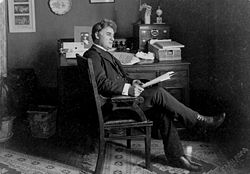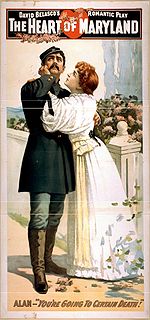- David Belasco
-
- Disambiguation: Also the name of his uncle, David James (actor).
David Belasco 
Between 1898 and 1916.Born July 25, 1853
San Francisco, California, USADied May 14, 1931 (aged 77)
New York City, New York, USAOccupation Theatrical producer Years active 1884 to 1930 Spouse Cecilia Loverich (c. 1880–1931) (his death) David Belasco (July 25, 1853 – May 14, 1931) was an American theatrical producer, impresario, director and playwright.
Contents
Biography
Born in San Francisco, California, where his Sephardic Jewish parents had moved from London, England, during the Gold Rush, he began working in a San Francisco theatre doing a variety of routine jobs, such as call boy and script copier.
He eventually was given the opportunity to act and serve as a stage manager, learning the business inside out. A gifted playwright, Belasco went to New York City in 1882 where he worked as stage manager for the Madison Square Theater, and then the old Lyceum Theatre while writing plays. By 1895, he was so successful that he set himself up as an independent producer.
During his long creative career, stretching between 1884 and 1930, Belasco either wrote, directed, or produced more than 100 Broadway plays including Hearts of Oak, The Heart of Maryland, and Du Barry, making him the most powerful personality on the New York city theater scene. Although he is perhaps most famous for having adopted the short story "Madame Butterfly" into a play with the same name and for penning The Girl of the Golden West for the stage, both of which were adapted as operas by Giacomo Puccini. More than forty motion pictures have been made from the many plays he authored, including Buster Keaton's Seven Chances.
Belasco was informally known in the theatrical community as "the Bishop of Broadway," due to his penchant for dressing in black clothing, which made him resemble a priest. Belasco was mentioned as a contemporary celebrity in Henry Miller's Tropic of Capricorn. In The Great Gatsby by F. Scott Fitzgerald, chapter III, page 45, Nick encounters "The Owl Eyed Man," who says of Gatsby "This fella's a regular Belasco," in reference to his giant library.
Many prominent performers of the late 19th and early 20th centuries sought the opportunity to work with Belasco; among them was a young Mary Pickford. Pickford appeared in his plays The Warrens of Virginia at the first Belasco Theatre in 1907 and A Good Little Devil in 1913. The two remained in touch after Pickford began working in Hollywood; Belasco appeared with her in the 1914 film adaptation of A Good Little Devil. He is also credited as giving Pickford her stage name.
David Belasco was married to Cecilia Loverich for over fifty years; they had two daughters, Reina and Augusta. He died in 1931 at the age of 77 in New York City and was interred in the Linden Hills Jewish Cemetery in Queens, New York. Find a Grave incorrectly lists Belasco as buried in the nearby Linden Hills "Methodist" Cemetery.
Influence on American theatre
Belasco is recognized for bringing a new standard of naturalism to the American stage. Supposedly he put appropriate scents to set scenes in the ventilation of the theaters, while his sets paid great attention to detail, and sometimes spilled out into the audience area. In one play, for instance, an operational laundromat was built onstage. In The Governor's Lady, there was a reproduction of a Childs Restaurant kitchen where actors actually cooked and prepared food during the play. He is even said to have purchased a room in a flop-house, cut it out of the building, brought it to his theater, cut out one wall and presented it as the set for a production. Belasco's original scripts were often filled with long, specific descriptions of props and set dressings. Interestingly, though, he has not been noted for producing unusually naturalistic scenarios.
Belasco was further known for his advanced lighting techniques and use of color to evoke mood and setting. He was one of the first directors to eschew the use of footlights in favor of follow spots and realistic lighting. Often, Belasco tailored his lighting configurations to complement the complexions and hair of the actors. In his own theatres, the dressing rooms were equipped with lamps of several colors, allowing the performers to see how their makeup looked under different lighting conditions.
Belasco also embraced existing theatre technology and sought to expand on it. Both of Belasco's New York theatres were built on the cutting edge of their era's technology. When Belasco took over the Republic Theatre he drilled a new basement level to accommodate his machinery; the Stuyvesant Theatre was specially constructed with enormous amounts of flyspace, hydraulics systems and lighting rigs. The basement of the Stuyvesant contained a working machine shop, where Belasco and his team experimented with lighting and other special effects. Many of the innovations developed in the Belasco shop were sold to other producers.
Theatres
The first Belasco Theatre in New York was located at 229 West 42nd Street, between 7th and 8th Avenues, in the Times Square district of Manhattan. Belasco took over management of the theater and completely remodeled it in 1902, only two years after it was constructed as the Theatre Republic by Oscar Hammerstein (the grandfather of the famous lyricist). He gave up the theater in 1910 and it was renamed the Republic. Under various owners, it went through a tumultuous period as a burlesque venue, hosted second-run and, eventually, pornographic films and fell into a period of neglect before being rehabilitated and reopened as the New Victory Theatre in 1995.
The second Belasco Theatre is located at 111 West 44th Street, between 6th and 7th Avenues, only a few blocks away from the New Victory. It was constructed in 1907 as the Stuyvesant Theatre and renamed after Belasco in 1910. The theater was built to Belasco's wishes, with Tiffany lighting and ceiling panels, rich woodwork and murals. His business office and private apartment were also housed there. The Belasco is still in operation as a Broadway venue with much of the original decor intact.
Belasco Theatres also existed in several other cities. The Los Angeles Belasco was built in 1926, is located at 1050 S. Hill St downtown and has been used as a church in recent years. The Shubert-Belasco Theatre, purchased by Belasco in September 1905, was located in Washington D.C. Originally built in 1895 as the Lafayette Square Opera House, at 17 Madison Place, across from the White House, the theater was razed in 1962 and replaced by the U.S. Court of Claims building.[1]
References
- Broadway Theatres: History and architecture, William Morrison, Dover Publications, 1999, ISBN 0-486-40244-4
- Sunshine and Shadows, Mary Pickford, Doubleday, 1956, AISN B0006AU3U6
- The Shuberts Present: 100 Years of American Theater, Maryann Chach, Reagan Fletcher, Mark Evan Swartz, Sylvia Wang, Harry N. Abrams, Inc. 2001, ISBN 0-8109-0614-7
- Theatre through Its Stage Door, David Belasco, New York and London: Harper & Brothers Publishers, 1919, published Sept. 1919. Also Ayer Co. Publishing (reprint), 1919, ISBN 0-405-08261-4
External links
Categories:- 1853 births
- 1931 deaths
- American theatre managers and producers
- American theatre directors
- American dramatists and playwrights
- Impresarios
- American entertainment industry businesspeople
- People from San Francisco, California
- 19th-century Sephardi Jews
- 20th-century Sephardi Jews
- Jewish American dramatists and playwrights
Wikimedia Foundation. 2010.

